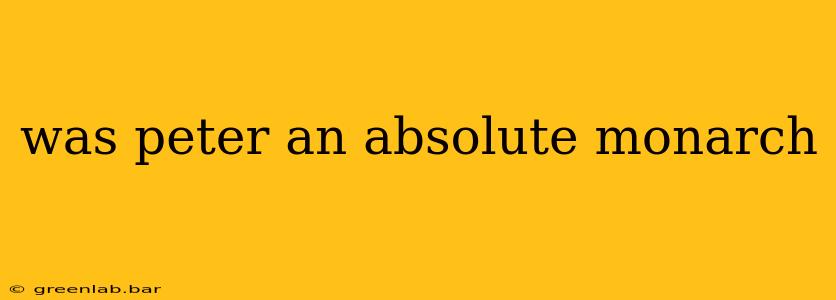The question of whether Peter the Great was an absolute monarch is complex, demanding a nuanced answer that goes beyond a simple "yes" or "no." While he undoubtedly held immense power and implemented sweeping reforms that centralized authority, the extent of his absolutism requires careful examination of his methods, the limits of his power, and the socio-political context of 18th-century Russia.
The hallmarks of Peter's Absolute Rule
Several key aspects of Peter the Great's reign strongly suggest absolute monarchical tendencies:
Centralization of Power:
Peter systematically dismantled the power of the boyar aristocracy, the traditional ruling class. He established a vast bureaucracy loyal to him personally, bypassing traditional power structures. The creation of new government departments and the introduction of a meritocratic system (at least in theory) further consolidated his control. This move away from feudal power structures towards a centrally governed state is a defining characteristic of absolutism.
Control over the Church:
Peter's subjugation of the Orthodox Church, placing it under direct state control through the Holy Synod, is another clear example of absolutist power. This removed a significant counterweight to his authority and allowed him to utilize the Church to further his political goals. This unprecedented level of control highlights his dominance over all aspects of Russian society.
Military Reforms and Expansion:
The massive military reforms undertaken by Peter, including the creation of a standing army and a modern navy, were funded and implemented through his absolute authority. These reforms, while modernizing Russia, also served to further consolidate his power through the control of a vast, loyal military force. His military successes and territorial expansion solidified his image as a powerful and indispensable leader.
Modernization through Decree:
Peter's modernization drive, encompassing aspects from infrastructure (building St. Petersburg) to fashion and social customs, was largely imposed from the top down. He issued decrees and enforced them with little regard for traditional customs or popular opinion, demonstrating an authoritarian approach indicative of absolute rule.
Limitations to Peter's Absolute Power
Despite his extensive authority, it's crucial to acknowledge certain limitations to Peter's absolutism:
Resistance from the Boyars:
While Peter successfully curbed the power of the boyars, he faced significant resistance and conspiracies throughout his reign. The constant threat of rebellion, though ultimately unsuccessful, highlights that his power was not entirely unchallenged.
Dependence on Bureaucracy:
Peter’s vast bureaucracy, while designed to strengthen his rule, also introduced a layer of complexity and potential for opposition. The effectiveness of his policies depended on the competence and loyalty of the appointed officials, introducing a degree of uncertainty.
Economic Constraints:
Peter’s ambitious modernization plans placed significant strain on the Russian economy. The need to raise taxes and enforce economic policies could generate dissent and potentially limit his actions.
Conclusion: A Qualified "Yes"
In conclusion, Peter the Great operated with an undeniable level of absolute power, centralizing authority, controlling the Church, and modernizing Russia through forceful decrees. However, his reign wasn't characterized by absolute, unchecked power. Resistance from the boyars, reliance on a complex bureaucracy, and economic considerations all placed limits on his authority. Therefore, while he exhibited many classic traits of an absolute monarch, it's more accurate to describe his rule as a qualified absolutism, acknowledging both the extensive powers he wielded and the inherent limitations on his absolute control. His legacy remains a subject of ongoing historical debate, reflecting the complex and nuanced nature of his rule.

